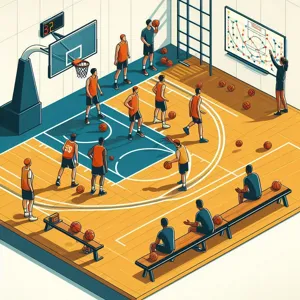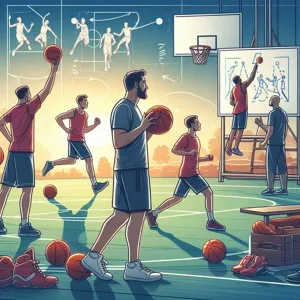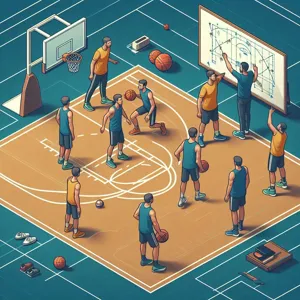Basketball is more than just a game of skill; it’s a dynamic ballet of strategy, teamwork, and split-second decisions that can make or break a season.
Whether you’re a seasoned coach looking to refine your playbook or an aspiring player eager to elevate your understanding of the game, mastering basketball strategy is essential for success on the court. In this ultimate playbook, we will delve into the top resources that can transform your approach to the game, from comprehensive coaching manuals and cutting-edge training videos to insightful analytics platforms and engaging podcasts. Prepare to unlock the secrets of offensive and defensive tactics, learn how to read the game like a pro, and discover innovative drills that will take your skills to the next level. Join us on this journey as we explore the invaluable tools that will empower you to navigate the complexities of basketball strategy and create winning plays that leave your opponents in the dust.
1. Introduction to Basketball Strategy

Basketball is more than just a game of skill; it’s a dynamic blend of strategy, teamwork, and adaptability. Understanding basketball strategy is crucial for players, coaches, and fans alike, as it lays the foundation for effective play and successful outcomes on the court. At its core, basketball strategy involves analyzing game situations, anticipating opponent movements, and making quick decisions that can shift the tide of play in your favor.
In this section, we’ll explore the fundamental concepts that underpin basketball strategy, from offensive and defensive principles to play-calling techniques and game management. Whether you’re a novice eager to grasp the basics or a seasoned player looking to refine your strategic approach, this introduction will provide the essential framework needed to elevate your understanding of the game.
We’ll delve into various offensive strategies, such as the pick-and-roll, isolation plays, and fast breaks, examining how they can create scoring opportunities while maintaining team cohesion. On the defensive end, we’ll highlight the significance of man-to-man versus zone defense, as well as the importance of communication and positioning to neutralize an opponent’s strengths.
Moreover, we’ll touch on the psychological aspects of basketball strategy, emphasizing the need for mental agility and the ability to read the game as it unfolds. Ultimately, mastering basketball strategy is about more than just executing plays; it’s about fostering a deep understanding of the game’s nuances that can make all the difference in high-pressure situations. As we embark on this journey through the ultimate playbook, prepare to unlock the insights that will empower you to become a strategic player or coach, elevating your game to new heights.
2. Understanding the Fundamentals of the Game
To master basketball strategy, one must first delve into the fundamentals of the game. This foundational knowledge serves as the bedrock upon which all advanced tactics and plays are built. Understanding the basic rules, positions, and movements is crucial for any aspiring coach or player.
Start with the core elements: **dribbling**, **shooting**, **passing**, and **defense**. Each of these skills is essential for effective gameplay, and a solid grasp of their mechanics can dramatically enhance a player’s performance. For instance, mastering dribbling techniques—not just the ability to move the ball up and down the court, but also the finesse to handle pressure from defenders—can open up opportunities for passing and scoring.
Equally important is the understanding of **offensive and defensive strategies**. This includes familiarizing oneself with various offensive sets, such as the pick-and-roll or motion offense, as well as different defensive formations like man-to-man and zone defense. Each strategy has its strengths and weaknesses, and knowing when to employ them can be the difference between winning and losing a game.
Moreover, grasping the importance of **court spacing** and player movement can significantly impact team dynamics. Effective spacing allows for better passing lanes and clearer shots, while intelligent movement can create mismatches and open up driving lanes.
Finally, familiarize yourself with the game’s terminology. Knowing the lingo—like “fast break,” “triple threat,” and “rebound”—not only enhances your understanding but also boosts your communication with teammates and coaches, fostering a more cohesive playing environment.
By committing to a thorough understanding of these fundamentals, players and coaches alike can elevate their game and employ more sophisticated strategies with confidence. Ultimately, the mastery of basketball begins with a solid foundation; once these basics are in place, the possibilities for creativity and innovation on the court become limitless.
3. Key Resources for Learning Offensive Strategies

When it comes to mastering offensive strategies in basketball, having the right resources at your fingertips can make all the difference. Whether you’re a player looking to sharpen your skills or a coach aiming to enhance your team’s performance, understanding the nuances of offensive play is crucial. Here are some key resources that can elevate your knowledge and application of offensive strategies on the court.
**Books and E-books:** Start with foundational texts that delve into the intricacies of offensive basketball. Titles like “Basketball Offense for Dummies” provide comprehensive explanations of various offensive systems, from the pick-and-roll to the motion offense. For more advanced readers, “The Basketball Playbook” offers a wealth of plays and diagrams that can be invaluable for both individual players and coaching staff.
**Online Courses and Webinars:** Numerous platforms, such as CoachTube and Udemy, offer online courses specifically focused on offensive strategies. These courses often feature video lectures from experienced coaches who dissect plays, analyze game footage, and provide practical drills to implement in practice. Webinars hosted by basketball training organizations also present opportunities to learn from the best in the field and ask questions in real-time.
**YouTube Channels and Podcasts:** Visual and auditory learners can benefit immensely from YouTube channels dedicated to basketball strategy. Channels like “ILoveBasketballTV” and “Basketball HQ” break down offensive sets and player movements through detailed video analyses. Additionally, podcasts such as “The Basketball Coaching Podcast” often feature interviews with professional coaches who share their insights on offensive tactics, helping you stay updated with the latest trends and ideas in the game.
**Mobile Apps:** In the digital age, apps like “FastDraw” and “Basketball Playbook” allow coaches to create, share, and store their own plays easily. These tools can be used to experiment with different offensive strategies, enabling you to visualize and tweak plays on the go. They also provide access to a library of plays from other coaches, offering a rich source of inspiration for your own offensive game plan.
By leveraging these key resources, you can deepen your understanding of offensive strategies, improve your decision-making on the court, and ultimately enhance your performance or that of your team. The world of basketball is ever-evolving, and with the right tools, you can stay ahead of the game.
4. Essential Defensive Tactics and Techniques
When it comes to mastering basketball strategy, defensive tactics are just as crucial as offensive plays. A solid defense can be the difference between victory and defeat, and understanding essential defensive techniques can elevate your team’s performance. Here are some key strategies to fortify your defense and disrupt the opposing team’s rhythm.
**1. Man-to-Man Defense:** This is the foundational defensive strategy where each player is assigned to guard a specific opponent. Effective communication and awareness are paramount here. Players must not only focus on their assigned man but also be alert to screens and cuts. Utilizing footwork and body positioning to anticipate the offensive player’s moves can lead to steals and forced turnovers.
**2. Zone Defense:** A zone defense can be an effective way to protect the basket and minimize driving lanes. In a zone setup, players cover specific areas of the court rather than individual opponents. This approach can confuse offenses that are reliant on one-on-one plays, forcing them to take low-percentage shots. Coaches should teach their players how to shift as a unit and close gaps quickly to respond to ball movement.
**3. Press Defense:** For teams looking to create chaos and capitalize on the opponent’s mistakes, a press defense can be a game-changer. This aggressive tactic applies pressure on the ball handler as soon as the ball is inbounded, often extending well into the backcourt. It aims to force hurried decisions and can lead to easy fast-break opportunities. However, it requires excellent stamina and communication among players to avoid getting burned by quick passes or fast breaks.
**4. Box-Out Techniques:** A strong defense goes beyond just preventing points; it’s also about controlling the rebounds. Teaching players proper box-out techniques ensures that they secure possession after a missed shot. Emphasizing the importance of positioning, leveraging body weight, and anticipating the ball’s trajectory can significantly improve a team’s rebounding statistics.
**5. Closeout Drills:** When a defender is forced to close out on a shooter, the technique can make or break a play. Proper closeout techniques involve sprinting toward the shooter while keeping a low center of gravity and arms extended to contest the shot without fouling. Practicing these drills ensures players are ready to respond effectively in high-pressure situations.
By integrating these essential defensive tactics and techniques into your team’s training regimen, you cultivate a more cohesive unit that can adapt to various offenses and create opportunities for success. Remember, in basketball, a robust defense is often the best offense!
5. Analyzing Plays: A Breakdown of Effective Game Plans

Analyzing plays is a crucial component of mastering basketball strategy, and understanding effective game plans can be the difference between victory and defeat. At its core, the analysis of plays involves dissecting how teams execute their strategies during live action, identifying the strengths and weaknesses of both your own team and your opponents.
Start by studying game footage—whether it’s your own team’s highlights or professional matches. Pay attention to player positioning, ball movement, and the decision-making process during crucial moments. Tools like video analysis software can help you slow down plays, allowing you to see the intricacies that determine success or failure. For instance, notice how a well-timed pick can create space for a shooter or how rapid ball movement can exploit defensive mismatches.
Moreover, understanding different offensive and defensive schemes is essential. Familiarize yourself with terms like “pick-and-roll,” “motion offense,” and “zone defense.” Each of these strategies has its own set of principles and best practices. For example, when breaking down a pick-and-roll play, analyze the roles of both the ball-handler and the screener, as well as the defenders’ responses. This not only helps in understanding your opponents’ tactics but also aids in developing your team’s own game plans.
Collaborate with coaches and teammates to discuss these analyses. Engage in strategy sessions where you can brainstorm adaptations to existing plays or develop new ones based on the insights you’ve gathered. Remember, basketball is a dynamic sport—what works one game may not work the next. Staying flexible and open to modification is key.
Finally, keep an eye on trends in the game. Basketball is ever-evolving, with new strategies and plays emerging regularly. Subscribing to basketball analytics blogs, attending coaching clinics, and engaging with the basketball community online can keep you informed. As you dive deeper into analyzing plays and breaking down effective game plans, you’ll not only enhance your understanding of the game but also empower your team to execute strategies with precision and confidence.
6. Utilizing Film Study for Strategic Improvement
In the realm of basketball strategy, film study has become an invaluable tool for coaches and players alike. It’s no longer just about watching the game unfold; it’s about dissecting every play, understanding the intricacies of your opponents’ tactics, and refining your own strategies. With access to advanced video technology, teams can now capture and analyze game footage like never before.
Utilizing film study begins with gathering relevant game footage, whether it’s from recent matches, practice sessions, or even historical games featuring championship teams. As a coach, you can break down these clips to highlight both successful plays and areas needing improvement. Players can see firsthand how their movements impact the game, allowing them to make necessary adjustments in their technique and decision-making.
Moreover, film study isn’t just about individual performance; it’s a collaborative process that fosters team dynamics. Watching film together can spark discussions about defensive formations, offensive plays, and even the psychological aspects of the game. This collective analysis helps players grasp their roles within the team framework and understand how to exploit opponents’ weaknesses.
Incorporating film study into your weekly training regimen can lead to significant strategic improvement. It promotes a deeper understanding of the game, enhances communication among players, and ultimately sharpens your team’s competitive edge. So, grab those clips, hit play, and prepare to elevate your basketball IQ!
7. Books Every Basketball Coach Should Read

For those looking to elevate their coaching game and deepen their understanding of basketball strategy, a wealth of wisdom can be found between the covers of some exceptional books. Each of these texts offers unique insights, innovative tactics, and time-tested principles that can transform how you approach the game. Here are a few must-read books every basketball coach should consider adding to their library:
**1. “The Basketball Coaching Bible” by The National Association of Basketball Coaches**
This comprehensive guide is a treasure trove of coaching techniques, drills, and philosophies from some of the most successful coaches in the game. It covers everything from player development to game strategy, making it an essential resource for coaches at all levels.
**2. “Make Your Own Damn Shots: 7 Steps to Becoming a Better Scorer” by Jim Boeheim**
Written by the legendary Syracuse University coach, this book delves into the art of scoring, emphasizing the importance of shot selection and offensive strategies. Boeheim’s insights are invaluable for coaches looking to help their players become more effective scorers on the court.
**3. “The New Basketball Encyclopedia” by Bill Simmons**
While not a traditional coaching manual, this encyclopedia provides an extensive overview of basketball history, strategies, and player profiles. It’s an engaging read that helps coaches understand the evolution of the game, enriching their strategic perspective.
**4. “Coaching Basketball Successfully” by Morgan Wootten**
Known as one of the greatest high school coaches of all time, Wootten shares his coaching philosophy and offers practical advice on building a successful program. His emphasis on character development alongside athletic skills is a vital lesson for any coach.
**5. “Playing Off the Ball” by Jerry Krause**
This book focuses on the importance of off-ball movement and spacing, crucial elements in creating effective offensive plays. Krause’s strategies can help coaches design plays that maximize their team’s potential and keep defenders guessing.
**6. “The Science of Coaching” by David J. Staley**
Staley’s work integrates psychology and coaching strategies, providing a unique perspective on how to motivate and develop athletes. This book is perfect for coaches looking to enhance their approach to player engagement and team dynamics.
**7. “Basketball Skills & Drills” by Jerry Krause, Don Meyer, and the National Association of Basketball Coaches**
A hands-on guide filled with practical drills and skill development techniques, this book is an invaluable resource for coaches at any level. The detailed breakdown of drills allows coaches to implement effective practice sessions that cater to their team’s specific needs.
By immersing yourself in these books, you’ll not only expand your knowledge of basketball strategy but also gain the tools to inspire and lead your team towards success. Whether you’re a seasoned coach or just starting out, these resources will equip you with the insights and strategies needed to elevate your coaching game and make a lasting impact on your players.
8. Online Courses and Clinics for Advanced Strategies
In today’s digital age, the wealth of knowledge available at our fingertips has transformed how players, coaches, and basketball enthusiasts alike can deepen their understanding of the game. Online courses and clinics have emerged as invaluable resources for mastering advanced basketball strategies, allowing you to learn from seasoned professionals regardless of your location.
Platforms like Coursera, Udemy, and even specialized sports websites offer courses tailored to various skill levels and focus areas—whether you’re interested in offensive tactics, defensive schemes, or the intricacies of player development. These courses often feature video lectures, interactive quizzes, and downloadable materials, providing a comprehensive learning experience that fits your schedule.
In addition to structured courses, many elite coaches and former professional players host virtual clinics and webinars. These sessions not only cover advanced strategies but also delve into the psychology of the game, helping participants understand how to motivate players and build cohesive, high-performing teams. Engaging with these experts in real-time offers a unique opportunity for Q&A, allowing you to clarify concepts and gain insights that you might not find in textbooks.
Furthermore, many online platforms have integrated community forums where participants can discuss strategies, share experiences, and critique game footage. This collaborative environment fosters a deeper understanding of how to apply advanced concepts in practical situations.
Investing time in these online courses and clinics will undoubtedly enhance your basketball IQ. By immersing yourself in a variety of strategies and perspectives, you’ll not only elevate your own game but also be better equipped to develop and inspire those you coach. As your knowledge expands, so too will your ability to anticipate and adapt to the ever-evolving game of basketball.
9. Podcasts and YouTube Channels Focused on Basketball Tactics
In the digital age, podcasts and YouTube channels have emerged as invaluable resources for basketball enthusiasts eager to deepen their understanding of tactics and strategy. These platforms not only provide rich, engaging content but also allow fans to access expert insights and analysis from the comfort of their homes or on the go.
Podcasts, in particular, offer a unique auditory experience. With expert coaches and former players sharing their knowledge while breaking down plays, discussing game theory, and analyzing recent matchups, listeners can absorb a wealth of information during their daily commutes or workouts. Shows like “The Basketball Coaches’ Podcast” and “The Lowe Post” delve into the intricacies of offensive and defensive schemes, providing listeners with actionable tips that can elevate their understanding of the game.
On the visual side, YouTube channels dedicated to basketball tactics bring strategy to life. Channels like “Coach Daniel” and “Basketball IQ” feature detailed breakdowns of plays, highlighting player movements, spacing, and the decision-making processes that lead to success on the court. These visual aids not only enhance comprehension but also allow viewers to see concepts in action, making it easier to translate theory into practice.
Moreover, many of these channels offer tutorials, drills, and analysis of specific games, allowing coaches and players to learn from both successes and mistakes in real-time. By subscribing to these resources, you ensure that your basketball knowledge is constantly evolving, giving you the tools to implement effective strategies in your own game or coaching.
Whether you prefer the immersive experience of podcasts or the visual storytelling of YouTube, tapping into these resources is a surefire way to enrich your basketball strategy and keep your skills sharp. The game is ever-changing, and staying informed through these mediums can give you a competitive edge, ensuring you’re not just following the sport but truly mastering it.
10. The Role of Analytics in Modern Basketball Strategy
In the fast-paced world of modern basketball, analytics has become an invaluable tool that reshapes how teams approach the game. Gone are the days when coaches relied solely on instinct and intuition; today, data-driven decision-making is at the forefront of basketball strategy. Analytics enables teams to dissect every aspect of the game, from player performance to opponent tendencies, allowing for more informed and strategic choices on the court.
Statistics such as player efficiency ratings, shot selection percentages, and defensive metrics provide a granular view of individual and team performances. Coaches and analysts pore over these figures to identify strengths and weaknesses, tailoring game plans that maximize their team’s potential while exploiting their opponents’ vulnerabilities. For instance, advanced metrics can reveal the effectiveness of different offensive sets or highlight which players excel in specific matchups, guiding coaches in making critical game-time decisions.
Moreover, the rise of tracking technology has revolutionized player analysis. Wearable devices and camera systems capture real-time data on player movements, shot angles, and even fatigue levels. This wealth of information not only enhances training regimens but also informs in-game strategies, allowing teams to adapt on the fly.
As the landscape of basketball continues to evolve, embracing analytics is no longer just an option; it’s a necessity for teams aspiring to gain a competitive edge. By harnessing the power of data, coaches and players can unlock new levels of performance, ensuring that they are not just playing the game, but mastering its strategic intricacies. For anyone looking to deepen their understanding of basketball strategy, delving into the world of analytics is a crucial step toward unlocking the full potential of the game.
11. Developing a Personal Playbook: Tips and Tools
Creating a personal playbook is an invaluable strategy for any basketball player looking to elevate their game. It serves as a tailored roadmap, reflecting your unique skills, strengths, and playing style while integrating proven tactics and strategies used by the pros.
To start, reflect on your position and the specific roles you play on the court. Are you a point guard orchestrating the offense, or a forward specializing in perimeter shooting? Understanding your role will help you identify the plays and strategies most applicable to your game.
Once you have a clear vision of your position, gather insights from various resources. Books like “Basketball on Paper” by Dean Oliver offer analytical perspectives on advanced statistics and strategy, while classic coaching manuals can provide foundational plays and drills. Online platforms like YouTube are treasure troves of instructional videos; tutorials from professional trainers and former players can introduce new moves or refine existing skills.
Additionally, utilize digital tools to enhance your playbook. Applications such as FastDraw allow you to diagram plays visually, creating a professional-looking playbook that you can reference during practice or pre-game warm-ups. Keeping a journal to jot down your thoughts, observations, and reflections after games will also help you continually refine your strategy and track your progression.
Moreover, don’t shy away from collaboration. Engaging with coaches, teammates, and even opponents can lead to valuable feedback and diverse perspectives on your playbook. Consider conducting practice sessions focused on specific plays or strategies, enabling you to test their effectiveness in a controlled environment.
Remember, your personal playbook is a living document. As you gain experience and evolve as a player, be open to revising and adapting your strategies. This ongoing process not only sharpens your basketball IQ but also empowers you to become a more versatile and effective player on the court. By investing time in developing your playbook, you’re not just preparing for games; you’re laying the groundwork for a successful basketball career.
12. Learning from the Pros: Case Studies of Successful Coaches
When it comes to mastering basketball strategy, there’s no better teacher than the pros themselves. Analyzing case studies of successful coaches provides invaluable insights that can elevate your understanding of the game and enhance your strategic thinking. Coaches like Phil Jackson, Greg Popovich, and Pat Riley have left indelible marks on the sport, not only through their championship titles but also through their innovative approaches to coaching.
Phil Jackson, renowned for his “Triangle Offense,” revolutionized how teams could create space, move the ball, and exploit defensive weaknesses. By studying his methods, you can gain a deeper appreciation for the importance of player movement and spacing, allowing you to implement similar principles in your own coaching or playing style.
Greg Popovich offers another rich vein of knowledge. His emphasis on team culture, selflessness, and continuous improvement has made the San Antonio Spurs a model franchise. Popovich’s case studies often highlight the significance of building strong relationships with players and fostering an environment where everyone feels valued. His approach teaches us that strategy isn’t just about X’s and O’s but also about nurturing the human elements that drive success.
Pat Riley’s strategic adaptability stands out, too. Known for his ability to shift tactics depending on the strengths of his roster, Riley’s case studies encourage aspiring coaches to be flexible and responsive to their team’s dynamics. His famous “Showtime” era with the Los Angeles Lakers emphasized fast breaks and high-scoring games, while his later teams showcased a more defensive, disciplined approach.
By delving into these case studies, you’ll uncover not just tactics, but philosophies that can shape your strategic mindset. Whether it’s through books, documentaries, or interviews, learning from these legendary coaches will provide a comprehensive understanding of basketball strategy that transcends the court. Embrace their experiences and insights, and watch as your game evolves to new heights.
13. Building Team Chemistry through Strategy
In the high-pressure world of basketball, where split-second decisions can dictate the outcome of a game, building team chemistry through strategic planning is essential for success. Strong team chemistry isn’t just about friendships or off-court camaraderie; it’s about understanding each player’s strengths, weaknesses, and preferred styles of play. When players are in sync, they can anticipate each other’s movements, communicate effectively on the court, and execute plays with precision.
To foster this chemistry, it’s crucial to involve the entire team in the strategy-building process. Coaches should facilitate open discussions where players can express their thoughts on tactics, share insights about their playing styles, and suggest how they can best contribute to team goals. This collaborative approach not only empowers players but also instills a sense of ownership over the game plan.
Additionally, regular team-building activities can strengthen relationships beyond the court, nurturing trust and camaraderie. Whether it’s through team outings, bonding exercises, or simply spending time together in practice sessions, these moments allow players to connect on a personal level, enhancing their on-court synergy.
Moreover, incorporating strategy sessions that focus on specific plays, defensive setups, and offensive movements can help players develop a shared understanding of their roles within the team dynamic. Reviewing game footage together also provides valuable opportunities for learning and growth, allowing players to analyze their performances and make adjustments collaboratively.
By prioritizing team chemistry through thoughtful strategy, teams can create a cohesive unit that not only executes plays effectively but also thrives under pressure, ultimately leading to a more successful and enjoyable basketball experience.
14. Adapting Strategies for Different Opponents
In basketball, one of the hallmarks of a great team is its ability to adapt strategies based on the strengths and weaknesses of its opponents. The dynamic nature of the game demands that coaches and players remain flexible, ready to pivot from a pre-planned approach to one that maximizes their chances of success against a particular competitor. This adaptability can be the difference between a decisive victory and a disappointing defeat.
To effectively adjust your strategy, it’s crucial to conduct thorough pre-game scouting of your opponents. Analyze their playing style—do they favor a fast-paced offense, or do they lean towards a more methodical approach? Are they reliant on a strong inside game, or do they excel at shooting from beyond the arc? By gathering this intel, you can tailor your game plan to exploit their vulnerabilities while reinforcing your own strengths.
Once the game begins, be prepared to think on your feet. If your opponent comes out with a surprising defense, such as a zone that you weren’t expecting, you may need to alter your offensive sets to find the right rhythm. This could mean bringing in a sharpshooter to stretch the floor or switching to a pick-and-roll strategy to create mismatches. The ability to read the game as it unfolds is invaluable, so encourage players to communicate and make quick decisions based on what they observe on the court.
Moreover, adaptability isn’t just about changing tactics; it’s about fostering a mentality within your team that embraces challenges. Players should be encouraged to think critically and creatively about how to counteract their opponents’ strategies. Drills that simulate different defensive setups or offensive schemes can prepare your team to respond with agility and confidence when faced with unexpected scenarios.
Ultimately, mastering the art of adapting strategies for different opponents is a continuous process. It’s about learning from each game, refining your approach, and cultivating a team culture that prioritizes intelligence and flexibility. By doing so, your team will not only become more formidable on the court but also develop the resilience needed to thrive in the competitive landscape of basketball.
15. Conclusion: Putting It All Together for Game Day Success
As we reach the conclusion of our ultimate playbook for mastering basketball strategy, it’s essential to recognize that success on game day is not just about individual skills or isolated tactics; it’s about the harmonious integration of all the resources and strategies we’ve discussed throughout this guide. Whether you’re a coach, a player, or an enthusiast, the key lies in understanding how to meld these elements into a cohesive game plan.
The resources we’ve explored—ranging from in-depth analytical tools and playbooks to coaching clinics and video breakdowns—serve as the foundation for your preparation. However, knowledge alone isn’t enough. To truly excel, you must translate that knowledge into action. This means practicing the strategies diligently, fostering communication among teammates, and creating a culture of adaptability that allows your team to respond to the dynamic nature of the game.
On game day, every decision counts. From the moment you step onto the court, the effectiveness of your preparation will be tested. Visualize your plays, trust in your practice, and maintain that strategic mindset. Remember, successful basketball is as much about mental resilience as it is about physical prowess.
As you implement these strategies, keep in mind that every game is a learning opportunity. After the final buzzer, take time to reflect on what worked, what didn’t, and how you can continue to evolve your approach. By continuously refining your strategy and staying committed to improvement, you not only enhance your own skills but also elevate the performance of your entire team.
In the ever-evolving landscape of basketball, mastery comes from a blend of preparation, execution, and reflection. With the resources and insights shared in this playbook, you’re well on your way to achieving game day success. Now, lace up your sneakers, gather your team, and get ready to turn theory into victory on the court!
In conclusion, mastering basketball strategy takes time, dedication, and the right resources. We hope this ultimate playbook has provided you with invaluable insights and tools to elevate your understanding of the game. From classic coaching books to innovative online courses and analytical tools, each resource is designed to sharpen your strategic thinking and enhance your gameplay. Whether you’re a player looking to refine your skills or a coach aspiring to lead your team to victory, these resources will empower you to make informed decisions on and off the court. Remember, the journey to becoming a basketball strategist is ongoing—continue to learn, adapt, and innovate. Now, grab that basketball, hit the court, and put your newfound knowledge into action!






